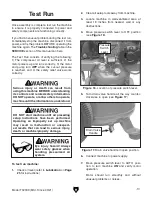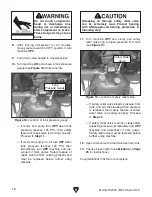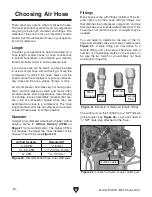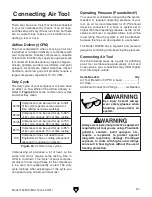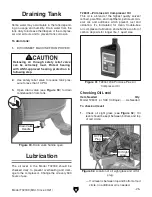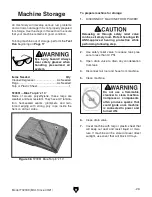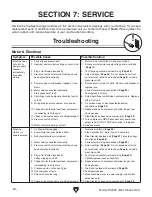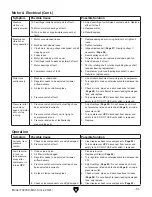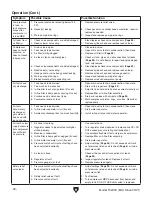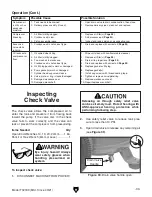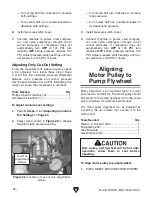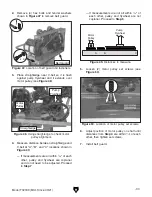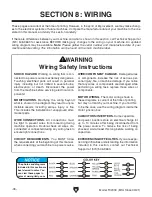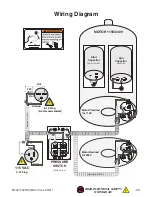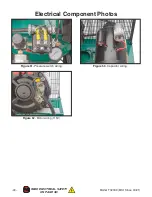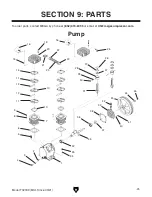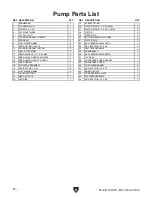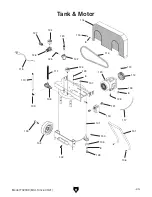
-30-
Model T32339 (Mfd. Since 03/21)
Review the troubleshooting procedures in this section if a problem develops with your machine. If you need
replacement parts or additional help with a procedure, call our Technical Support.
Note: Please gather the
serial number and manufacture date of your machine before calling.
SECTION 7: SERVICE
Troubleshooting
Motor & Electrical
Symptom
Possible Cause
Possible Solution
Machine does
not start, or
power supply
breaker
immediately
trips after
startup.
1. Tank already pressurized.
2. Incorrect power supply voltage or circuit size.
3. Plug at fault/wired incorrectly.
4. Pressure switch cut-in/cut-out settings have
been adjusted incorrectly.
5. Power supply circuit breaker tripped or fuse
blown.
6. Motor wires connected incorrectly.
7. Start capacitor at fault.
8. Centrifugal switch adjustment/contact points
at fault.
9. Wiring broken, disconnected, or corroded.
10. Tripped motor thermal overload; compressor
is exceeding its duty cycle.
11. Check valve components are dirty/damaged.
12. Pressure switch at fault.
13. Motor or motor bearings at fault.
1. Motor will not start if tank is fully pressurized.
2. Ensure correct power supply voltage and circuit size
(
Page 11).
3. Test for good contacts/correct wiring (
Page 39).
4. Adjust settings (
Page 35). Do not exceed cut-in/cut-
out pressures listed on data sheet (
Page 6) or inside
pressure switch.
5. Ensure circuit is free of shorts. Reset circuit breaker or
replace fuse.
6. Correct motor wiring connections (
Page 39).
7. Test/replace if at fault.
8. Adjust centrifugal switch/clean contact points. Replace
either if at fault.
9. Fix broken wires or disconnected/corroded
connections (
Page 39).
10. Reduce load on compressor and allow longer cool
down periods.
11. Clean/replace check valve components (
Page 33).
12. Turn compressor
OFF, disconnect from power, and
empty tank. DO NOT USE until switch is replaced.
13. Replace motor.
Machine
stalls or is
underpowered.
1. Air filter(s) dirty/clogged.
2. Pump/motor have restricted airflow.
3. Belt slipping/pulleys misaligned.
4. Motor wires connected incorrectly.
5. Pressure switch cut-in/cut-out settings have
been adjusted incorrectly.
6. Plug at fault/wired incorrectly.
7. Pulley slipping on shaft.
8. Tripped motor thermal overload; compressor
is exceeding its duty cycle.
9. Crankcase oil is not correct type.
10. Run capacitor at fault.
11. Extension cord too long.
12. Check valve components are dirty/damaged.
1. Replace air filter(s) (
Page 26).
2. Clean cylinder fins, motor fan, and vent area.
3. Clean/tension/replace belt (
Page 27); ensure pulleys
are aligned (
Page 36).
4. Correct motor wiring connections (
Page 39).
5. Adjust settings (
Page 35). Do not exceed cut-in/cut-
out pressures listed on data sheet (
Page 6) or inside
pressure switch.
6. Test for good contacts/correct wiring (
Page 39).
7. Tighten/replace loose pulley/shaft.
8. Reduce load on compressor and allow longer cool
down periods.
9. Drain and replace with correct oil (
Page 25).
10. Test/repair/replace.
11. Move machine closer to power supply; use shorter
extension cord.
12. Clean/replace check valve components (
Page 33).
Summary of Contents for T32339
Page 48: ......


